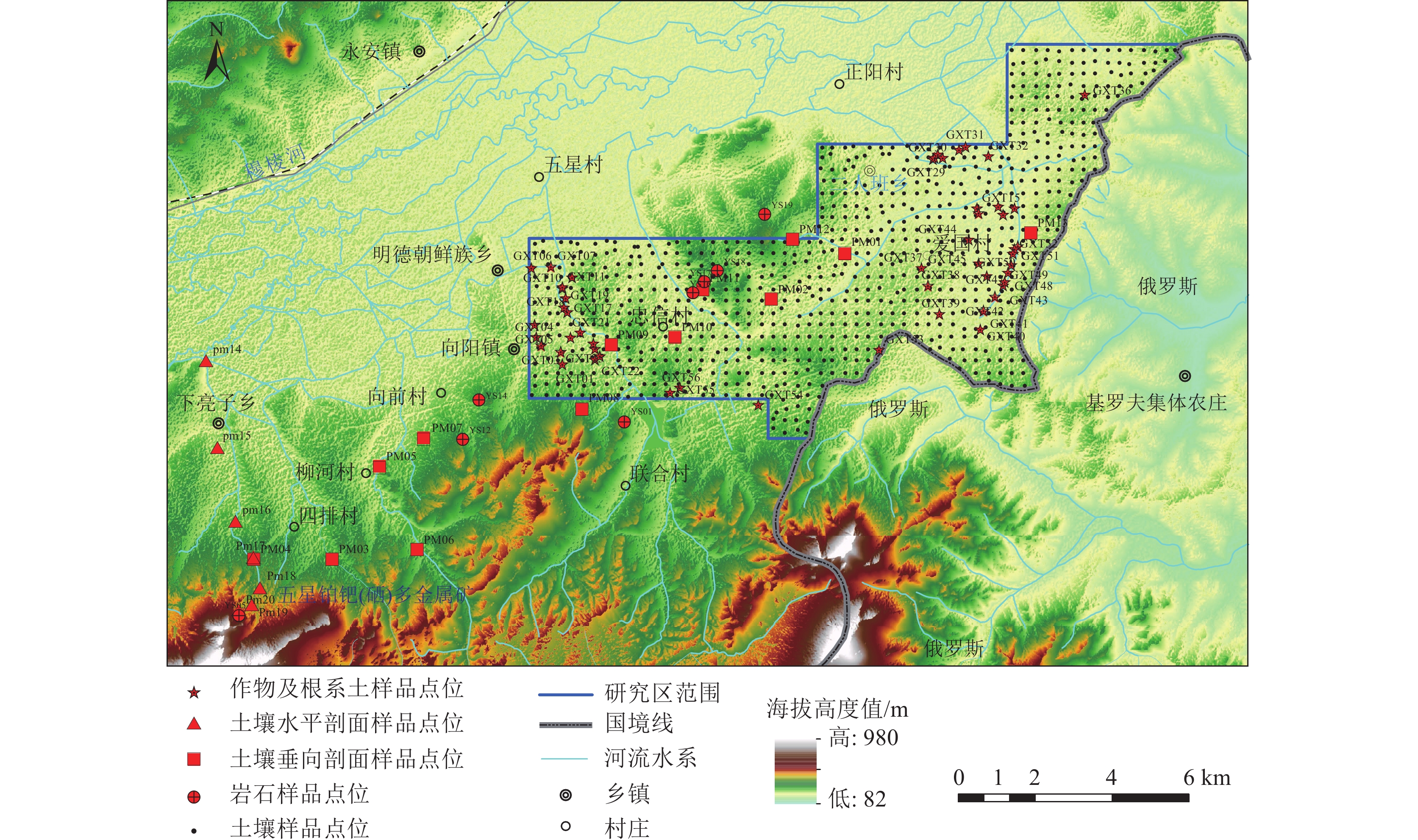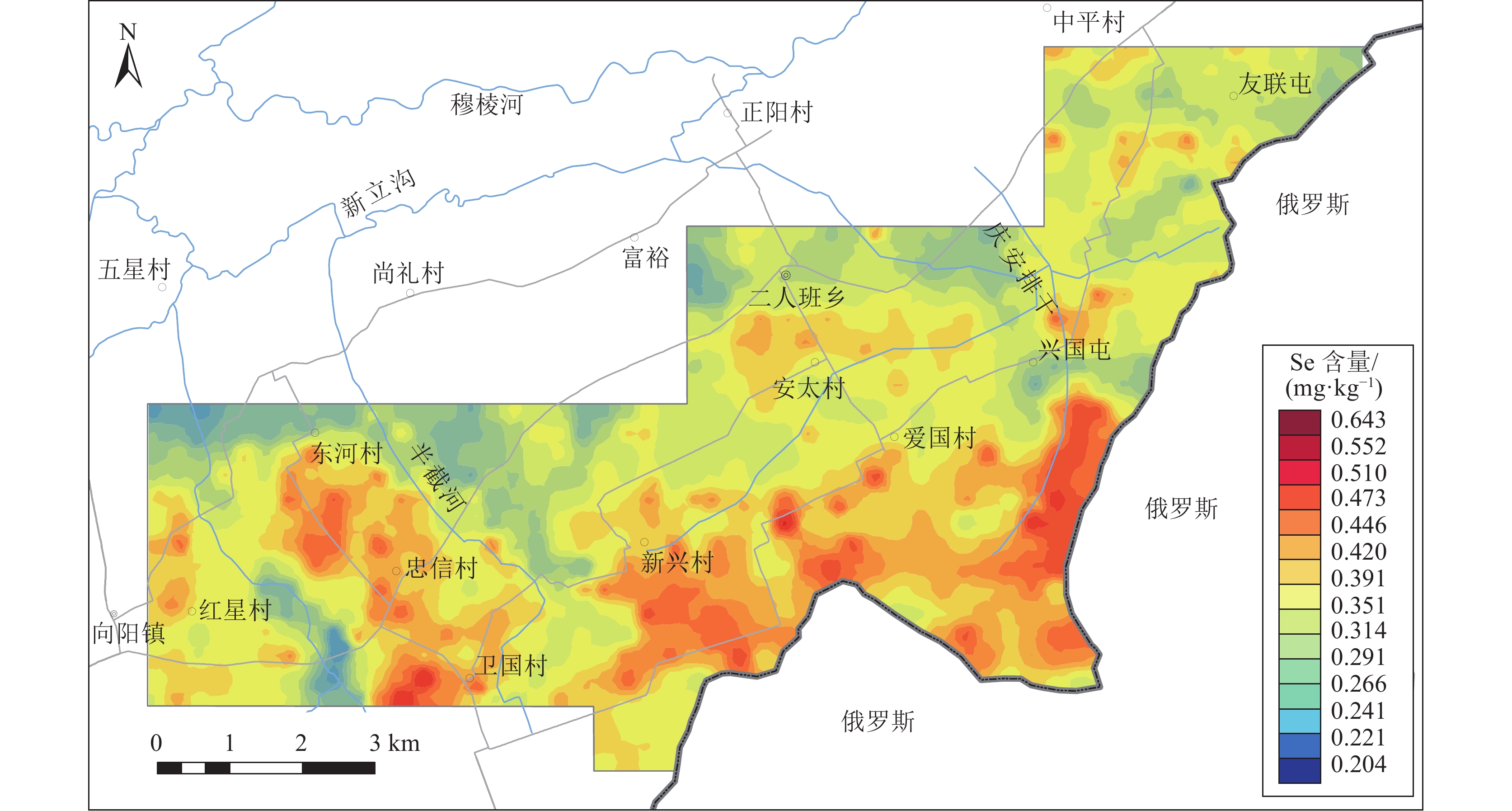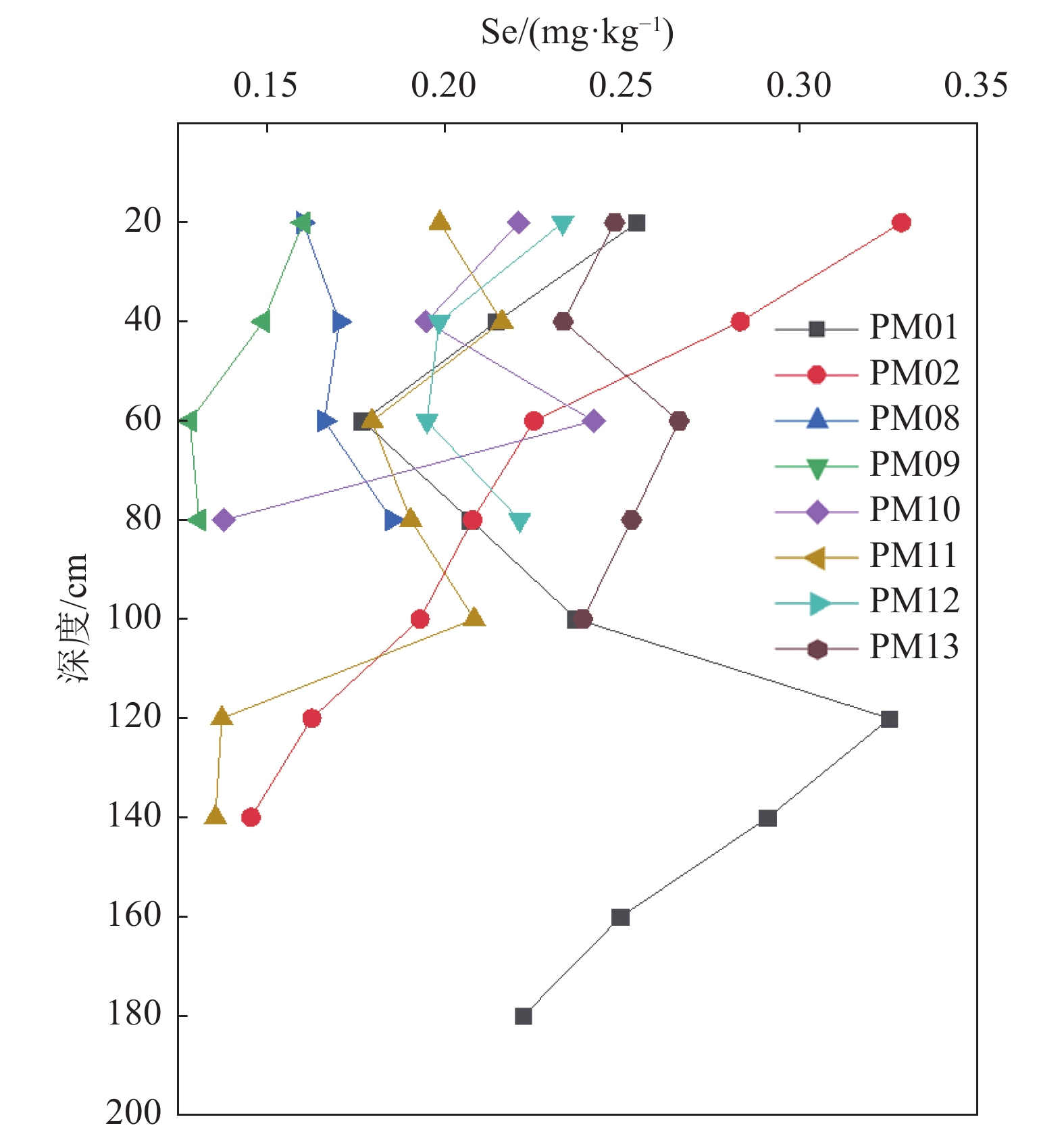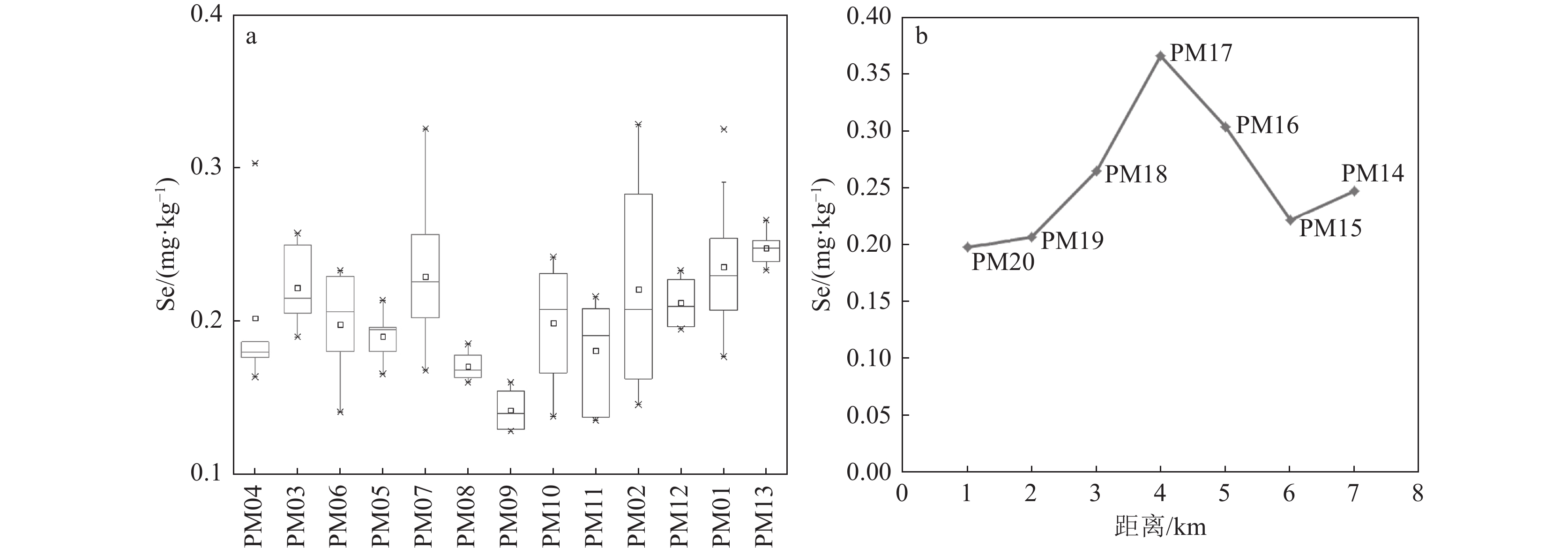Analysis of selenium content characteristics, origin and main controlling factors of migration transformation in soil−plant system, in west Xingkai Lake
-
摘要:
硒及其有机化合物对生物体具有重要的生物活性和特殊的保健功能,开展富硒土壤硒成因来源和迁移转化研究,对富硒土地利用和富硒功能产品研发具有重要的科学和经济意义。基于区域地质特征、土壤数据和植物籽实数据,开展土壤硒空间分布和成因来源研究,运用地统计学、相关性、生物富集系数等方法探讨硒在土壤−植物系统中的迁移转化主控因素。土壤Se含量为 0.11~0.70 mg/kg,均值为 0.37 mg/kg,含量特征及空间分布主要受成土母质控制;富锦组黑色岩系是形成富硒土壤的物质基础和Se元素的最初来源,后期有利的古气候环境演化促进了黑色岩系的持续风化,为土壤提供了丰富的硒源;植物富集能力BCF水稻/土壤>BCF玉米/土壤,籽实Se平均含量为Se水稻>Se玉米,含量与土壤理化指标相关性揭示,硒在土壤−植物系统中迁移转化受土壤矿物组成及土壤环境等因素制约。土壤硒主要来源于富锦组黑色岩系及其风化物,硒在土壤−植物系统中迁移转化主控因素为粘土矿物的吸附/解析作用;划定天然富硒土地6550.68 hm2,为富硒土地科学利用和富硒功能产品开发提供地学依据,有效支撑服务地方经济发展和疾病预防。
Abstract:Selenium and its organic compounds have important biological activities and special health care functions for living organisms, and research on selenium genesis and transport of selenium in selenium-enriched soils is of great scientific and economic significance for selenium-enriched land utilization and selenium-enriched functional product development.Based on the regional geological features, soil data and plant seed data, and research on the spatial distribution and genesis of soil selenium, and explored the main controlling factors of selenium transport and transformation in the soil-plant system by using geostatistics, correlation and bioconcentration coefficients. The soil selenium content ranged from 0.11 mg/kg to 0.70 mg/kg, with an average value of 0.37 mg/kg, and the content characteristics and spatial distribution were mainly controlled by the soil-forming parent material; Fujin Formation black rock series was the material basis for the formation of selenium-rich soils and the initial source of selenium, and the favorable palaeoclimatic environment in the later stages of evolution promoted the continued weathering of the black rock series, which provided a rich source of selenium for the soils; the plant enrichment capacity of the BCFrice/soil> BCFmaize/soil, and the average seed selenium content Serice> Semaize,and the correlation between the selenium content and soil physicochemical indexes revealed that selenium transport and transformation in the soil-plant system are regulated by soil mineral composition and soil environment. Soil selenium mainly comes from Fujin Formation black rock series and its weathered materials, adsorption/resolution of clay minerals as the main controlling factor of selenium transport and transformation in soil-plant system; 6550.68 hm2 of natural selenium-enriched land was delineated, which would provide a geomorphological basis for the scientific utilization of selenium-enriched land and development of selenium-enriched functional products, effectively support services for local economic development and disease prevention.
-

-
表 1 元素分析方法及检出限
Table 1. Elemental analysis methods and detection limits
mg/kg 元素 检出限 分析方法 元素 检出限 分析方法 Se 0.01 AFS S 26 VOL SiO2* 0.05 XRF Cu 0.29 ICP-MS Al2O3* 0.02 ICP-OES Pb 0.3 ICP-MS TFe2O3* 0.02 XRF Zn 0.6 XRF CaO* 0.03 XRF Mn 4 XRF MgO* 0.03 XRF Mo 0.06 ICP-MS Na2O* 0.03 XRF Co 0.12 XRF K2O* 0.02 ICP-OES Ni 0.80 XRF pH 0.10 ISE Ge 0.059 ICP-MS Corg* 0.03 VOL 注:标注*的元素计量单位为%。AFS—原子荧光光谱法;XRF—X射线荧光光谱法;ICP-OES—电感耦合等离子体发射光谱法;ISE—离子选择性电极法;VOL—容量法; ICP-MS—电感耦合等离子体质谱法 表 2 土壤硒地球化学参数
Table 2. Statistics on soil selenium geochemical parameters
mg/kg 项目 样本数 平均值 最小值 25%
分位数中位值 75%
分位数最大值 标准差 变异
系数Se 836 0.37 0.11 0.31 0.37 0.42 0.70 0.08 0.22 pH 5.82 4.09 5.63 5.81 5.93 7.78 0.32 0.06 Corg 2.09 1.16 1.83 2.05 2.32 4.43 0.40 0.19 表 3 土壤垂向剖面基础信息
Table 3. Basic information of soil vertical profile
编号 地层单位 成土母质类型 土壤类型 土地利用类型 种植作物类型 PM01 坡积裙(Qhp) 残积母质 白浆土 旱地 玉米 PM02 坡积裙(Qhp) 残积母质 白浆土 旱地 玉米 PM03 坡积裙(Qhp) 残积母质 草甸土 旱地 玉米 PM04 坡积裙(Qhp) 残积母质 草甸土 旱地 玉米 PM05 坡积裙(Qhp) 残积母质 沼泽土 水田 水稻 PM06 坡积裙(Qhp) 残积母质 白浆土 旱地 玉米 PM07 坡积裙(Qhp) 残积母质 沼泽土 水田 水稻 PM08 杨岗组(P2-3y) 残积母质 草甸土 旱地 玉米 PM09 坡积裙(Qhp) 残积母质 水稻土 水田 水稻 PM10 富锦组(Nf) 残积母质 白浆土 旱地 玉米 PM11 富锦组(Nf) 残积母质 白浆土 旱地 玉米 PM12 富锦组(Nf) 残积母质 白浆土 旱地 玉米 PM13 富锦组(Nf) 残积母质 白浆土 旱地 玉米 PM14 坡积裙(Qhp) 残积母质 草甸土 旱地 玉米 PM15 坡积裙(Qhp) 残积母质 草甸土 旱地 玉米 PM16 坡积裙(Qhp) 残积母质 白浆土 旱地 玉米 PM17 富锦组(Nf) 残积母质 草甸土 旱地 玉米 PM18 坡积裙(Qhp) 残积母质 草甸土 旱地 玉米 PM19 坡积裙(Qhp) 残积母质 草甸土 旱地 玉米 PM20 坡积裙(Qhp) 残积母质 草甸土 旱地 玉米 表 4 研究区出露主要地层岩性及Se含量
Table 4. Selenium content of the main stratigraphic lithologies exposed in the study area
样品岩性 数量 含量/
(mg·kg−1)平均值/
(mg·kg−1)含量/(mg·kg−1) 灰绿色铂钯(硒)
稀土矿6 4.67~8.50 6.47 0.073(谭见安,1996) 灰绿色粗粒辉绿岩 1 0.52 0.52 黑色层状泥页岩 2 0.25~0.35 0.30 黑色黑云母片岩 7 0.08~0.15 0.10 黑色气孔状玄武岩 4 0.05~0.06 0.057 表 5 土壤Se含量与土壤理化指标相关性分析
Table 5. Correlation analysis between soil selenium content and soil physicochemical indexes
元素 样本数 SiO2 Al2O3 TFe2O3 K2O Na2O CaO MgO Corg pH Se 836 −0.112** 0.155** 0.183** 0.163** −0.113** −0.077* 0.221** 0.090** −0.017 元素 样本数 S Cu Pb Zn Mn Mo Co Ni Ge Se 836 0.158** 0.122** 0.340** −0.011 0.248** 0.201** 0.328** 0.134** 0.180** 注:*表示在0.05 水平(双侧)上显著相关;**表示在0.01 水平(双侧)上显著相关 表 6 根系土Se含量及玉米、水稻籽实Se含量统计
Table 6. Statistics of selenium content in root soil and selenium content in corn and rice seeds
mg/kg 植物 项目 样本 平均
值最小值 25%
分位数中值 75%
分位数最大值 标准差 CV/% 水稻 根系土 32 0.29 0.22 0.25 0.03 0.32 0.40 0.05 17.24 籽实 0.03 0.01 0.02 0.03 0.04 0.09 0.02 66.67 玉米 根系土 21 0.35 0.29 0.32 0.36 0.37 0.41 0.04 11.42 籽实 0.02 0.01 0.01 0.02 0.03 0.04 0.01 50.00 表 7 植物Se含量与土壤理化指标相关性统计
Table 7. Statistics of correlation between plant selenium content and soil physicochemical indexes
作物类型 样本数 SiO2 TFe2O3 Al2O3 K2O Na2O CaO MgO Se Corg pH 水稻 32 0.122 −0.102 −0.059 0.164 0.239 0.043 −0.209 0.139 −0.051 0.275 玉米 21 0.385* −0.279 −0.372* 0.353* 0.451** −0.225 −0.243 0.235 −0.273 −0.087 注:*表示在0.05 水平(双侧)上显著相关;**表示在0.01 水平(双侧)上显著相关 -
[1] Anamika K, Lalit G, Jechan L, et al. 2021. Selenium in soil-microbe-plant systems: Sources, distribution, toxicity, tolerance, and detoxification[J]. Critical Reviews in Environmental Science and Technology, 52(13): 2383−2420. doi: 10.1080/10643389.2021.1883187
[2] Dinh Q T, Cui Z W, Huang J, et al. 2018. Selenium distribution in theChinese environment and its relationship with humanhealth: A review[J]. Environment International, 112: 294−309. doi: 10.1016/j.envint.2017.12.035
[3] Etteieb S, Magdouli S, Zolfaghari M, et al. 2020. Monitoring and analysis of selenium as an emerging contaminant in mining industry: A critical review[J]. Science of the Total Environment, 698: 134339. doi: 10.1016/j.scitotenv.2019.134339
[4] Fan H, Wen H. 2011. Selenium speciation in Lower Cambrian Se-enriched strata in South China and its geological implications[J]. Geochimica et Cosmochimica Acta, 75(23): 7725−7740. doi: 10.1016/j.gca.2011.09.027
[5] Favorito J E, Luxton T P, Eick M J, et al. 2017. Selenium speciation in phosphate mine soils and evaluation of a sequential extraction procedure using XAFS[J]. Environmental Pollution, 229: 911−921. doi: 10.1016/j.envpol.2017.07.071
[6] Haug A, Graham R D, Christophersen O A, et al. 2007. How to use the world’s scarce selenium resources efficiently to increase the selenium concentration in food[J]. Microb. Ecol. Health. Dis., 19(4): 209−228.
[7] Heath J C, Banna K M, Reed M N, et al. 2010. Dietary selenium protects against selected signs of aging and methylmercury exposure[J]. Neurotoxicology, 31(2): 169−179. doi: 10.1016/j.neuro.2010.01.003
[8] Johnsson L. 1991. Selenium uptake by plants as a function of soil type, organic matter content and pH[J]. Plant and Soil, 133(1): 57−64. doi: 10.1007/BF00011899
[9] Kieliszek M, Błazejak S. 2016. Current knowledge on the importance of selenium in food for living organisms: A review[J]. Molecules, 21(5): 609. doi: 10.3390/molecules21050609
[10] Layton-Matthews D, Leybourne M I, Peter J M, et al. 2013. Multiple sources of selenium in ancient seafloor hydrothermal systems: compositional and Se, S, and Pb isotopic evidence from volcanic-hosted and volcanic-sediment-hosted massive sulfide deposits of the Finlayson Lake District, Yukon, Canada[J]. Geochim et Cosmochim Acta, 117: 313−331. doi: 10.1016/j.gca.2013.05.002
[11] Masscheleyn P H, Delaune R D, Patrick W H J. 1990. Transformations of selenium as affected by sediment oxidation-reduction potential and pH[J]. Environmental Science & Technology, 24(1): 91−96.
[12] Michalke B. 2018. Selenium Molecular and integrative toxicology[M]. Cham, Switzerland: Springer International: 393-412.
[13] Ozaltun B, Selamoglu Z. 2018. A review on the importance of selenium compounds in the cardiovascular system[J]. SciFed Journal of Cardiology, 2(3): 1−5.
[14] Pappas A C, Zoidis E, Chadio S E. 2019. Maternal selenium and developmental programming[J]. Antioxidants, 8(5): 145. doi: 10.3390/antiox8050145
[15] Ryant P, 2020. Antoˇsovský J, Adam V, et al. The importance of selenium in fruit nutrition[J]. Fruit Crops, 241-254.
[16] Reich H J, Hondal R J. 2016. Why nature chose selenium[J]. ACS Chemical Biology, 11(4): 821−841. doi: 10.1021/acschembio.6b00031
[17] Sakr T M, Korany M, Katti K V. 2016. Selenium nanomaterials in biomedicine —— an overview of new opportunities in nanomedicine of selenium[J]. Journal of Drug Delivery Science and Technology, 46: 223−233.
[18] Wasserman N L, Schilling K, Johnson T M, et al. 2021. Selenium isotope shifts during the oxidation of selenide-bearing minerals[J]. ACS Earth and Space Chemistry, 5(5): 1140−1149. doi: 10.1021/acsearthspacechem.1c00036
[19] Wesselink E, Koekkoek W A C, Grefte S, et al. 2019. Feeding mitochondria: potential role of nutritional components to improve critical illness convalescence[J]. Clin. Nutr., 38(3): 982−995. doi: 10.1016/j.clnu.2018.08.032
[20] 安永龙, 殷秀兰, 金爱芳, 等. 2023. 河北张家口市某种植区土壤营养元素生态化学计量与空间分异特征[J]. 地质通报, 42(2/3): 443−459.
[21] 陈健, 刘文中. 2008. 中国煤中硒的研究综述[J]. 煤质技术, 5(19): 75−78.
[22] 方如康. 2003. 环境学词典[J]. 北京: 科学出版社: 127−128.
[23] 黑龙江省地质矿产局. 1993. 黑龙江省区域地质志[M]. 北京: 地质出版社.
[24] 冯爱平, 康鹏宇, 刘传朋, 等. 2023. 山东沂南土壤−植物系统中硒生物有效性评价[J]. 吉林大学学报(地球科学版), 53(4): 1216−1227.
[25] 黑龙江省地质调查研究总院. 2004. 鸡西市幅1∶250000区域地质调查报告[R].
[26] 蒋梅茵, 杨德涌, 熊毅. 1982. 中国土壤胶体研究Ⅷ: 五种主要土壤的粘粒矿物组成[J]. 土壤学报, 19(1): 62−70.
[27] 梁树能, 李光辉, 孙景贵, 等. 2009. 黑龙江五星铜镍、铂钯矿床镁铁质杂岩的元素地球化学特征与岩石成因[J]. 世界地质, 28(1): 28−36.
[28] 梁帅, 朱建新, 戴慧敏, 等. 2021. 黑龙江拜泉地区Se元素在土壤-植物系统中的迁移富集规律[J]. 地质与资源, 30(4): 456−464,478.
[29] 梁帅, 戴慧敏, 刘国栋, 等. 2022. 黑龙江双阳河流域土壤−作物−人体系统中Se元素及生态环境与人体健康评价[J]. 中国地质, 49(4): 1064−1074. doi: 10.12029/gc20220403
[30] 刘凯, 戴慧敏, 刘国栋, 等. 2022. 基于主成分聚类分析法的典型黑土区土壤地球化学分类[J]. 物探与化探, 46(5): 1132−1140.
[31] 林克惠, 赵平, 祖艳群. 2002. 微量元素对作物和人体的毒害作用及其控制[J]. 云南农业大学学报, 17(1): 94−98.
[32] 曲关生. 2008. 黑龙江省岩石地层[M]. 北京: 中国地质大学出版社.
[33] 邵国璋, 关光伟. 1993. 黑龙江省土壤硒(Se)元素背景值与地方性疾病的关系[J]. 中国环境监测, 9(2): 61−62. doi: 10.19316/j.issn.1002-6002.1993.02.029
[34] 谭见安. 1996. 环境生命元素与克山病[M]. 北京: 中国医药科技出版社.
[35] 田贺忠, 曲益萍, 王艳, 等. 2009. 中国燃煤大气硒排放及其污染控制[J]. 中国电力, 42(8): 53−57. doi: 10.3969/j.issn.1004-9649.2009.08.013
[36] 吴健, 沈吉. 2009. 兴凯湖沉积物磁化率和色度反映的28 kaBP以来区域古气候环境演化[J]. 海洋地质与第四纪地质, 29(3): 123−131.
[37] 杨泽, 刘国栋, 戴慧敏, 等. 2021. 黑龙江兴凯湖平原土壤硒地球化学特征及富硒土地开发潜力[J]. 地质通报, 40(10): 1773−1782. doi: 10.12097/j.issn.1671-2552.2021.10.019
[38] 自然资源部中国地质调查局. 2021. 天然富硒土地划定与标识 (DZ/T 0380—2021)[S] .
[39] 张莹. 2007. 中国煤中硒的含量、赋存状态及环境效应研究[D]. 中国科学技术大学硕士学位论文.
[40] 赵辰, 孙彬彬, 周国华, 等. 2023. 福建龙海市土壤营养元素全量特征及有效量预测[J]. 地质通报, 42(10): 1784−1791.
[41] 中华人民共和国国土资源部. 2016. 土地质量地球化学评价规范(DZ/T 0295—2016)[S].
[42] 中国环境监测总站. 1990. 中国土壤元素背景值[M]. 北京: 中国环境科学出版社.
-



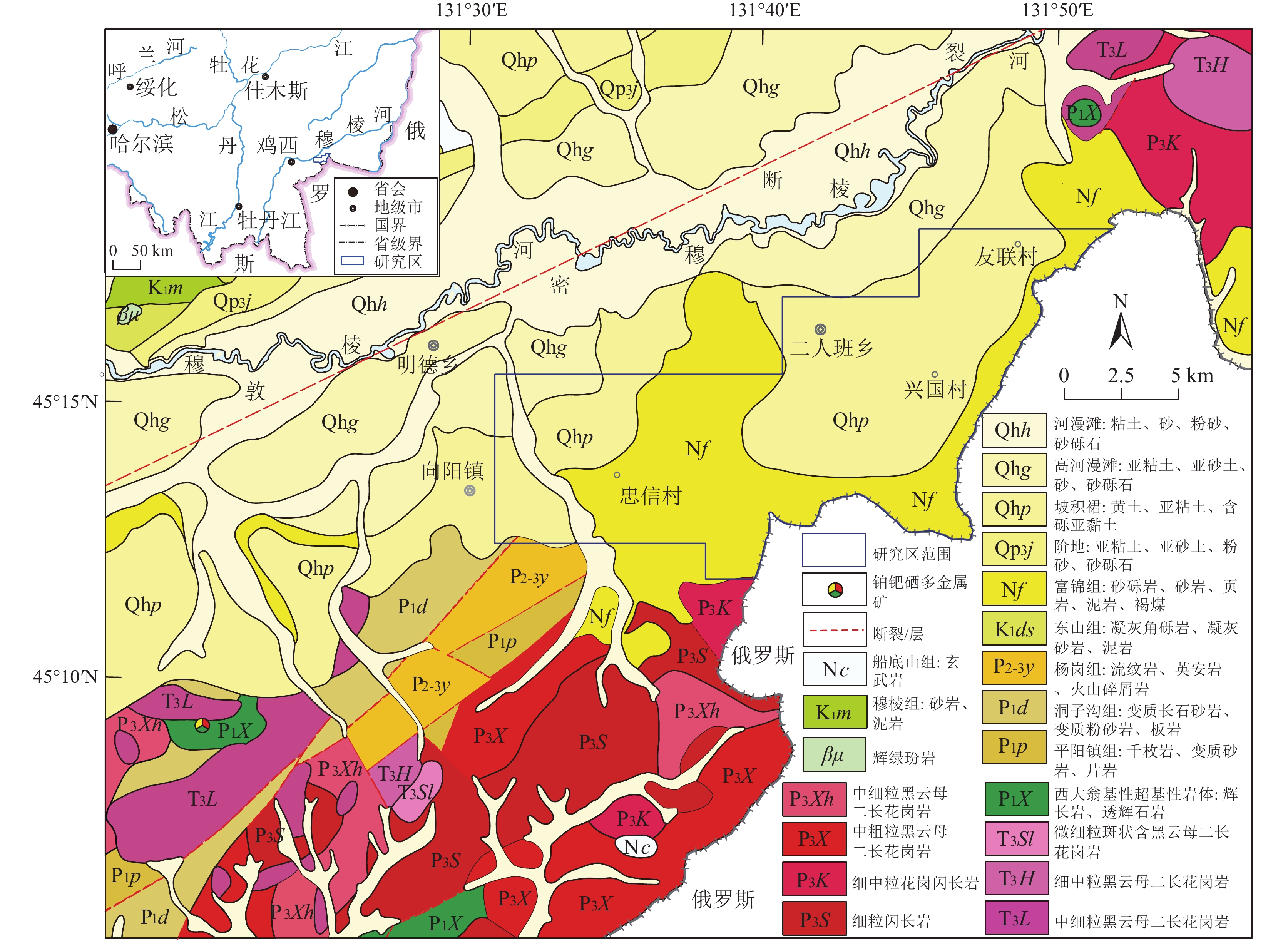
 下载:
下载:
